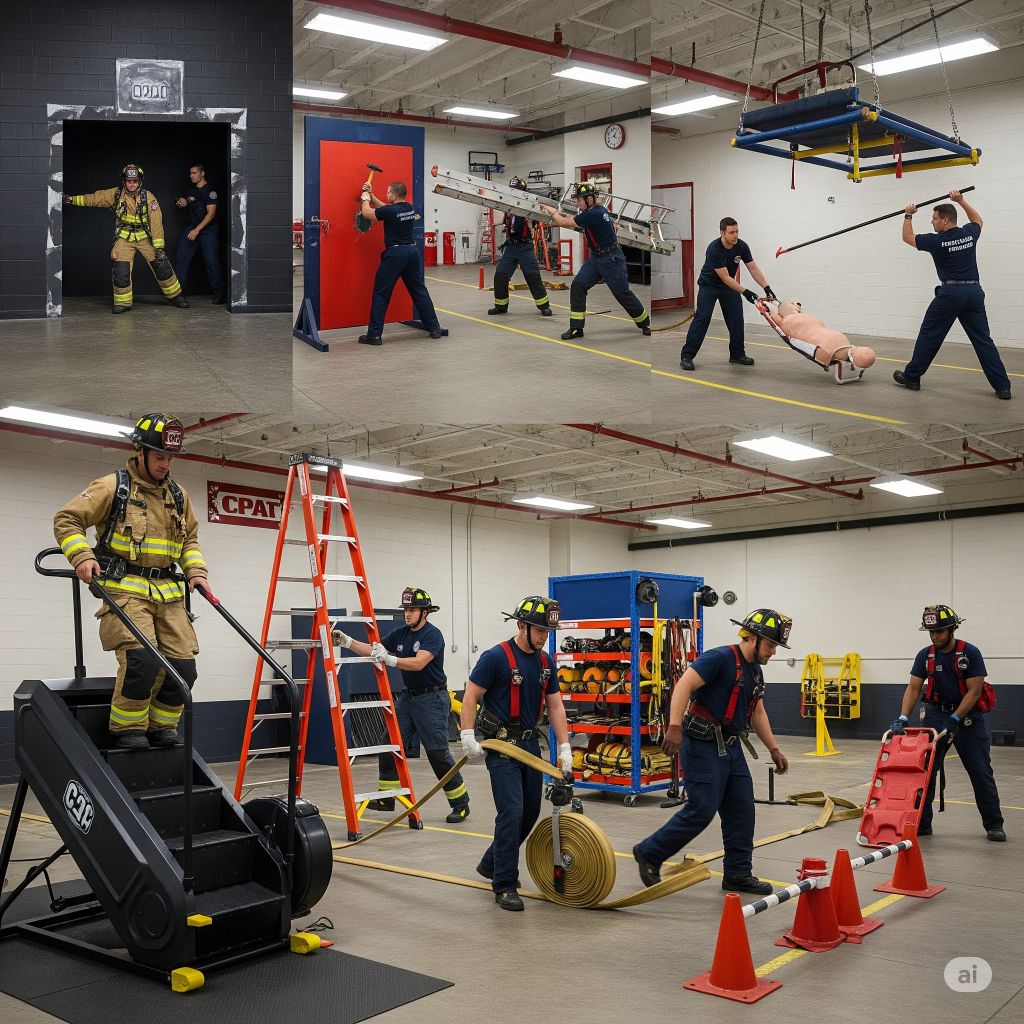
Training for CPAT is crucial for success. As someone who has gone through the process myself, I understand the challenges and importance of proper preparation. In this article, I’ll share valuable insights and tips to help you ace your CPAT test.
Whether you’re a seasoned athlete or just starting your fitness journey, CPAT training requires a specific focus. I’ll guide you through the essential exercises and techniques to enhance your strength and endurance effectively. With the right approach, you can build the confidence needed to excel in the CPAT test.
Key Takeaways
- Understanding the CPAT test structure and requirements is essential for effective training tailored to each event’s demands
- Prioritize physical fitness components like endurance, strength, and cardiovascular fitness to excel in the CPAT test
- Design a well-rounded CPAT training program that includes clear goals, structured workouts, test condition simulations, interval training, and form/technique focus
- Include key exercises like stair climbing, equipment carry, hose drag, dummy drag, ladder raise/extension, and forcible entry simulator to improve essential fitness components
- Maintain a balanced diet rich in protein, carbohydrates, and healthy fats, stay hydrated, prioritize quality sleep, and incorporate recovery techniques to support CPAT training and performance
Understanding the CPAT Test
When preparing for the CPAT (Candidate Physical Ability Test), it’s crucial to have a good understanding of what the test entails. Here are some key points to keep in mind:
- The CPAT is a standardized test used to assess the physical abilities of candidates applying for firefighting positions.
- It consists of eight events that simulate tasks firefighters might encounter on the job, such as climbing stairs, dragging hoses, and simulating forcible entry.
- The test is designed to evaluate a candidate’s strength, endurance, and overall physical fitness to ensure they can perform the duties required of a firefighter effectively.
- Each event has specific time limits that candidates must meet to pass the test successfully.
Having a clear understanding of the CPAT test structure and requirements is essential for tailoring your training regimen effectively. With this knowledge, you can focus on improving your performance in each event to increase your chances of success on test day.
Importance of Physical Fitness
I can’t stress enough how crucial physical fitness is when it comes to preparing for the CPAT. Let’s break it down:
- Endurance and stamina are essential for enduring the demanding tasks of the test.
- Strength training helps in lifting equipment and performing physical tasks effectively.
- Cardiovascular fitness is vital for maintaining energy levels throughout the test.
Minimizing rest periods between exercises and focusing on full-body workouts are key to improving overall physical readiness.
Efficient training routines that target different aspects of fitness, such as cardio, strength, and flexibility, are vital for success in the CPAT. Tailoring workouts to simulate test conditions can significantly enhance performance on the day of the test.
Designing Your CPAT Training Program
When designing my CPAT training program, I focus on incorporating a balance of endurance, strength training, stamina, and cardiovascular exercises to prepare my body for the challenges of the test. Here are some key elements I consider:
- Setting clear goals: I establish specific and achievable goals for each aspect of the CPAT to track my progress effectively.
- Creating a structured workout plan: I develop a well-rounded workout plan that includes a mix of cardiovascular exercises, strength training, and endurance workouts.
- Simulating test conditions: I structure my workouts to mimic the format of the CPAT, including timed exercises and rest periods to build test-specific stamina.
- Incorporating interval training: I integrate interval training into my routine to improve both cardiovascular fitness and endurance levels.
- Focusing on form and technique: I pay close attention to my form and technique during exercises to prevent injuries and optimize performance.
- Tracking progress: I regularly assess my performance and make adjustments to my training program based on my progress and areas that need improvement.
By designing a tailored CPAT training program that targets all essential fitness components and reflects the test conditions, I can maximize my physical readiness and enhance my performance on test day.
Key Exercises for CPAT Preparation
When preparing for the CPAT, it’s crucial to include specific exercises in your training program to target the essential fitness components required for success. Incorporating a variety of functional movements that mimic the tasks in the test can help improve your endurance, strength, and overall performance. Here are some key exercises to include in your CPAT preparation:
- Stair Climbing: Practice climbing stairs with a weighted vest to simulate the aerobic demands of the CPAT.
- Equipment Carry: Incorporate exercises like farmer’s walks or kettlebell carries to improve your grip strength and muscular endurance.
- Hose Drag: Mimic the hose drag task by pulling a sled or heavy object along the ground to enhance your upper body strength.
- Dummy Drag: Perform sled drags or tire drags to simulate dragging a rescue dummy and work on your leg strength.
- Ladder Raise and Extension: Use a ladder to practice extending and raising it to strengthen your core muscles and shoulder stability.
- Forcible Entry Simulator: Include exercises like sledgehammer slams or tire strikes to improve your upper body power and explosiveness.
By incorporating these key exercises into your CPAT training program, you can target the specific physical abilities required for success in the test. Remember to progressively overload your workouts, focus on proper form, and stay consistent with your training to optimize your performance on the CPAT.
Nutrition and Recovery Strategies
When it comes to CPAT training, nutrition plays a vital role in supporting performance and recovery. I focus on consuming a balanced diet rich in protein, carbohydrates, healthy fats, and hydration to fuel my body for intense workouts and aid in muscle repair.
I ensure that I eat quality meals that provide essential nutrients to sustain my energy levels throughout the day. Incorporating pre and post-workout snacks helps me optimize my exercise sessions and facilitate better recovery.
Hydration is key in maintaining performance and preventing dehydration during training sessions. I make sure to drink enough water before, during, and after my workouts to keep my body hydrated and functioning effectively.
In addition to focusing on nutrition, adequate recovery strategies are crucial to maximize the benefits of CPAT training. I prioritize quality sleep to allow my body to repair and regenerate after demanding workouts. Implementing rest days into my training schedule is essential to prevent overtraining and reduce the risk of injuries.
I also incorporate stretching, foam rolling, and other recovery techniques to alleviate muscle soreness and improve flexibility. By paying attention to both nutrition and recovery, I ensure that my body is primed for CPAT training and performance.
Conclusion
Prioritizing nutrition and recovery strategies is key to excelling in CPAT training. A well-rounded diet and proper hydration play a crucial role in enhancing performance and aiding in post-workout recovery. Additionally, incorporating sufficient rest, quality sleep, and recovery techniques such as stretching and foam rolling are essential for optimizing CPAT training benefits. By focusing on these aspects, individuals can ensure their bodies are adequately prepared for the rigors of CPAT exercises, ultimately leading to improved overall performance.
Frequently Asked Questions
What role does nutrition play in CPAT training?
Nutrition plays a crucial role in CPAT training by providing the necessary fuel for energy, muscle recovery, and overall performance. A balanced diet rich in proteins, carbohydrates, and healthy fats is essential for optimizing training results.
How important is hydration during CPAT training?
Hydration is extremely important during CPAT training to maintain performance levels, prevent dehydration, and support muscle function. Proper hydration helps in regulating body temperature and ensuring optimal performance during intense exercise.
Why is recovery important in CPAT training?
Recovery is essential in CPAT training to allow muscles to repair and strengthen, reducing the risk of injury and improving overall performance. Adequate rest, quality sleep, and recovery techniques like stretching and foam rolling are vital for optimizing training benefits.
